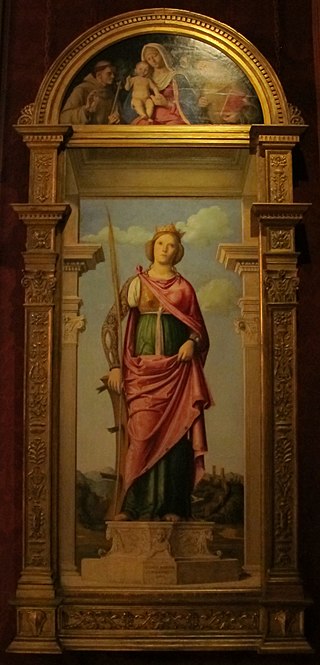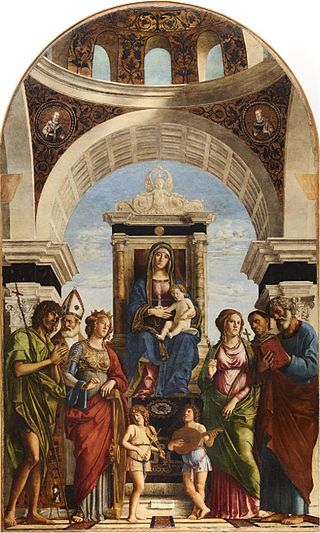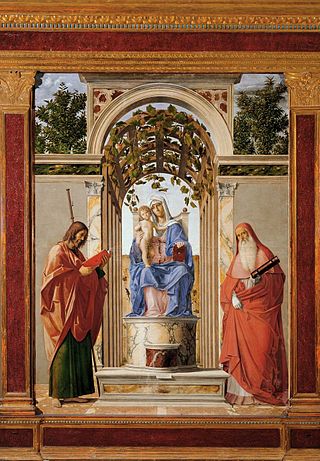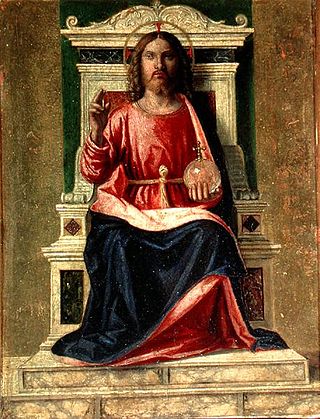
The Basilica dei Santi Giovanni e Paolo, known in Venetian as San Zanipolo, is a Catholic minor basilica and Dominican conventual church in the Castello sestiere of Venice, Italy.

Giovanni Battista Cima, also called Cima da Conegliano, was an Italian Renaissance painter, who mostly worked in Venice. He can be considered part of the Venetian school, though he was also influenced by Antonello da Messina, in the emphasis he gives to landscape backgrounds and the tranquil atmosphere of his works.

Giovanni di Niccolò Mansueti was an Italian painter.

Marco Palmezzano (1460–1539) was an Italian painter and architect, belonging to the Forlì painting school, who painted in a style recalling earlier Northern Renaissance models. He was mostly active near Forlì.
Giovanni Martini or Giovanni Martini da Udine was an Italian painter and sculptor of the Renaissance, born in Udine between 1470 and 1475. With Pellegrino da San Daniele he is one of the main representatives of Renaissance art in the Friuli region of north-east Italy.
Events from the year 1516 in art.
The decade of the 1490s in art involved some significant events.

Santa Maria dei Carmini, also called Santa Maria del Carmelo and commonly known simply as the Carmini, is a large Roman Catholic church in the sestiere, or neighbourhood, of Dorsoduro in Venice, northern Italy. It nestles against the former Scuola Grande di Santa Maria del Carmelo, also known as the Scuola dei Carmini. This charitable confraternity was officially founded in 1597, and arose from a lay women's charitable association, the Pinzocchere dei Carmini. The members of this lay group were associated as tertiaries to the neighbouring Carmelite monastery. They were responsible for stitching the scapulars for the Carmelites.

San Francesco is a Gothic-style, Roman Catholic church and Monastery located in the Piazza of the same name in Sansepolcro, province of Arezzo, region of Tuscany, Italy.

The Madonna and Child with Saints Michael the Archangel and Andrea is a Cima da Conegliano painting oil on panel dating from c. 1496–1498, and preserved at the Galleria nazionale di Parma.

Santa Maria Maggiore, also known as the church of San Francesco is a Roman Catholic church in the town of Miglionico, province of Matera, Basilicata, Italy.

Saints Peter, Martha, Mary Magdalen and Leonard or Four Saints is a 1514 oil on canvas altarpiece by Correggio, now in the Metropolitan Museum of Art in New York City. He painted it for the church of Santa Maria della Misericordia and it shows Saint Peter, Saint Martha, Mary Magdalene and Leonard of Noblac.

Saints Roch, Anthony Abbot and Lucy or Three Saints is a 1513 oil on canvas painting by Cima da Conegliano, which is now in the collection of the Metropolitan Museum of Art in New York.

The Mestre Altarpiece was a c. 1500–1502 altarpiece by Cima da Conegliano. The side panels of Saint Roch and Saint Sebastian from the work are now in the Musée des Beaux-Arts in Strasbourg, whilst the central section showing St Catherine of Alexandria and the lunette of Madonna and Child between St Dominic and St Francis are both in the Wallace Collection in London. The central section is signed on a pedestal "JOANIS BABTISTE CONEGLANESIS OPUS".

Olera Altarpiece is an oil on panel nine-panel altarpiece by Cima da Conegliano, created c. 1486–1488, housed in the parish church in Olera.

The Conegliano Altarpiece or Madonna and Child with Angels and Saints is an oil painting produced in 1492 by Cima da Conegliano as the high altarpiece for the Duomo di Conegliano in his birthplace.

Madonna and Child Enthroned with Saints is a 1496–1498 oil painting by Cima da Conegliano, originally painted on panel but later transferred to canvas. It is also known as the Dragan Altarpiece after Giorgio Dragan, a shipowner who commissioned it for his personal altar in the church of Santa Maria della Carità in Venice. To the left of the throne is a female saint, George and Nicholas, whilst to the right are Anthony Abbot, Sebastian and another female saint.

Madonna and Child Enthroned with Saint James and Saint Jerome is a 1489 oil painting by Cima da Conegliano, originally painted on panel and later transferred to canvas. It shows James the Great and Jerome either side of an enthroned Madonna and Child and now hangs in the Pinacoteca civica in Vicenza, housed in the Palazzo Chiericati.

Madonna and Child is a 1504 oil on panel painting by Cima da Conegliano, now in a private collection. It was last sold at Christie's in London on 25 November 1966 as part of a sale of works from Sir Herbert Cook's collection and is therefore sometimes known as the Cook Madonna, not to be confused with another painting of that name by Crivelli now known to be the central panel of the Porto San Giorgio Altarpiece.

Christ Enthroned is a tempera on panel painting with gold leaf background by Cima da Conegliano, painted before 1505. Christ is seated on a marble throne, two fingers of his right hand raised in a benediction, and the left hand holding a globus cruciger. It measures 20 cm × 15 cm and was initially part of a larger altarpiece, probably its predella. It was owned by Friedrich von Pourtalès then Osip Braz, and was seized from the latter by the Soviet state on the October Revolution and assigned to the Hermitage Museum. It was transferred to the Pushkin Museum in Moscow in 1928, where it still hangs.

















